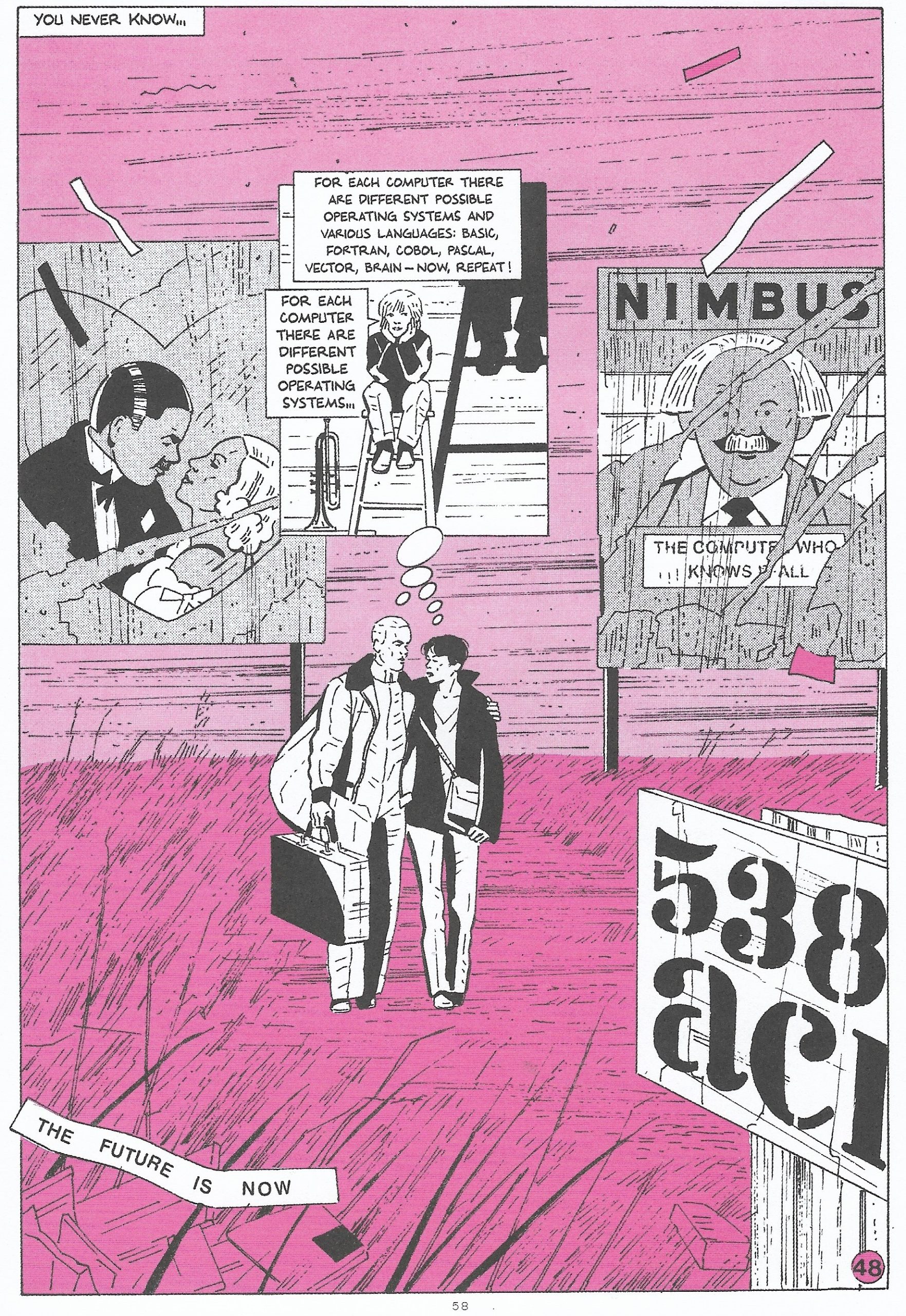FWIW, one of my favorite things I’ve published in recent years is this reflection on the big Blake exhibition at the Tate Gallery.
would it kill you to allow the occasional German word

I’ve made a case for reading the news less often.
periodicity
This piece from the Dispatch (possibly paywalled) on how The New York Times misled its readers with an overly “Hamas-friendly” headline makes a valid point, I guess — but I think much of the problem here is baked-in to minute-by-minute journalism. You don’t have to be a hard-core opponent of Israel to get a headline like that wrong — in the heat of the moment even a slight lean towards the people living in Gaza might be enough to influence your headline. If you have to post something on your website, and post it right now, you’ll not be consistently judicious and fair-minded.
[UPDATE: The Times has published an apology.]
I didn’t know that the Times had perpetrated this headline because any political crisis strengthens me in the habits I have been trying to cultivate for some years now: to watch no TV news at all — that part’s easy, I haven’t seen TV news in the past thirty years, except when I’m in an airport — and to read news on a once-a-week rather than a several-times-a-day basis. My primary way to get political news, national and international, is to read the Economist when it shows up at my house, which it does on Saturday or Monday. (I don’t keep the Economist app on my phone.) I have eliminated political sites from my RSS feed, and only happened upon the Dispatch report when I was looking for something else at the site.
The more unstable a situation is, the more rapidly it changes, the less valuable minute-by-minute reporting is. I don’t know what happened to the hospital in Gaza, but if I wait until the next issue of the Economist shows up I will be better informed about it than people who have been rage-refreshing their browser windows for the past several days, and I will have suffered considerably less emotional stress.
It’s important to remember this: businesses that rely on constant online or televisual engagement — social media platforms, TV news channels, news websites — make bank from our rage. They have every incentive, whether they are aware of it or not, to inflame our passions. (This is why pundits who are always wrong can keep their jobs: they don’t have to be right, they just have to be skilled at stimulating the collective amygdala.) As the intervals of production increase — from hourly to daily to weekly to monthly to annually — the incentives shift away from being merely provocative and towards being more informative. Rage-baiting never disappears altogether, but books aren’t well-suited to it: even the angriest book has to have passages of relative calm, which allows the reader to stop and think — a terrible consequence for the dedicated rage-baiter.
“We have a responsibility to be informed!” people shout. Well, maybe, though I have in the past made the case for idiocy. But let me waive the point, and say: If you’re reading the news several times a day, you’re not being informed, you’re being stimulated. Try giving yourself a break from it. Look at this stuff at wider intervals, and in between sessions, give yourself time to think and assess.
UPDATE 2023–10–23: One tiny result of the Israel/Gaza nightmare, for me, is that it has revealed to me those among the writers I follow via RSS who are prone to making uninformed, dimwitted political pronouncements. Those feeds I have deleted without hesitation.
I’m really worried about Bandcamp, which is a unique and probably irreplaceable service. At this point, there’s one thing we all ought to have learned: when the founders of a service or app we love sell it, that means it’s time for us to get out. It will not last in the form we love. Key quote from the piece:
Cultural theorist Cory Doctorow coined the term ‘enshittification’ to describe the agonizing process by which online platforms shift their focus from end users to maximizing value for their shareholders. It’s a crudely effective concept capable of capturing everything from the declining quality of Google’s search results to the way your Instagram feed is full of Reels you never asked to see. (Let’s not even get started on the rot at the heart of whatever Twitter is now.) When Bandcamp’s founders sold the company to Epic, that should have been the first sign that the platform belonged to someone other than its users. Songtradr’s layoffs and promises of synergy with its music licensing business are the next indicator that the ugly specter of enshittification may be nigh. The saddest thing is, aside from a benevolent billionaire sweeping in and buying up the site, or building out an alternative, there are no easy answers here. It’s another reminder that the independent music ecosystem is far more fragile than anyone would like to admit.
A fascinating account of the endlessly variable and thus confusing history of the word “Palestine.”
Anthony Lane on the science of happiness:
Whether there is still a place for the steady intellectual grind is open to question. Readers and publishers alike are worried by all that worrying. Understandably, their quest is for books that promise results, primed to beef up one’s eudaemonia levels like a shot of Vitamin B12. Hence the speed with which the mood of Brooks’s book, grammatical and tonal, is set within the title: not “How to Build” but “Build.” Thereafter, the imperative reigns supreme. “Start by working on your toughness.” No sweat. “Take your grand vision of improvement and humble ambition to be part of it in a specific way and execute accordingly.” Check. “Rebel against your shame.” Done. “Widen your conflict-resolution repertoire.” Ka-pow! “Treat your walks, prayer time, and gym sessions as if they were meetings with the president.” Which President? “Journal your experiences and feelings over the course of the day.” Since when did “journal” turn into a transitive verb? “Dig into the extensive and growing technology and literature on mindfulness.” Sorry, I was miles away, what? Above all, “Remember: You are your own CEO.” Holy moly. Do I have to wear a suit to brush my teeth? Is my dog a shareholder? Were last year’s migraines tax-deductible? Can I be fired by me?
But even at night ...
Clockmakers, flush with commissions, let their horological imaginations run wild. They mounted every last thing they could think of on their clocks: trumpeting angels, wheels of fortune, planets and stars wheeling around in epicycles – take that, astrolabe – and panoplies of bells to add to the din of holy clanging. The still-extant clock of Wells Cathedral, constructed about 1390, is a carnival of time. A face of three concentric circles shows the 24 hours, the position of the sun and the phases of the moon, all decorated with stars, angels and depictions of the four cardinal winds. Every fifteen minutes, four knights come out to joust. Above the clock an automaton (‘Jack Blandifer’) kicks his heels on bells every quarter hour. In the 15th century an exterior clock was geared onto it: two axe-men stand and strike two more bells on the hour. Nequid pereat, runs the inscription – let nothing perish, no matter how whimsical.
Here is the marvelous clock of Wells Cathedral:

(Larger version, well worth inspecting, here.) And here, at least as admirable, is Simon Armitage’s glorious poem “Poetry”:
In Wells Cathedral there’s this ancient clock,
three parts time machine, one part zodiac.
Every fifteen minutes, knights on horseback
circle and joust, and for six hundred yearsthe same poor sucker riding counterways
has copped it full in the face with a lance.
To one side, some weird looking guy in a frock
back-heels a bell. Thus the quarter is struck.It’s empty in here, mostly. There’s no God
to speak of — some bishops have said as much —
and five quid buys a person a new watch.
But even at night with the great doors lockedchimes sing out, and the sap who was knocked dead
comes cornering home wearing a new head.

Ida York Abelman, “Man and Machine”
I wrong a longish and complicatedish post on conceptual screens and diseases of the intellect.
diseases of the intellect
Twenty years ago, I had an exceptionally intelligent student who was a passionate defender of and advocate for Saddam Hussein. She wanted me to denounce the American invasion of Iraq, which I was willing to do — though not in precisely the terms that she demanded, because she wanted me to do so on the ground that Saddam Hussein was a generous and beneficent ruler of his people. That is, her denunciation of America as the Bad Guy was inextricably connected with her belief that there simply had to be on the other side a Good Guy. The notion that the American invasion was wrong but also that Saddam Hussein’s tyrannical rule was indefensible — that pair of concepts she could not simultaneously entertain. Because there can’t be any stories with no Good Guys … can there?
This student was not a bad person — she was, indeed, a highly compassionate person, and deeply committed to justice. She was not morally corrupt. But she was, I think, suffering from a disease of the intellect.
What do I mean by that? Everyone’s habitus includes, as part of its basic equipment, a general conceptual frame, a mental model of the world that serves to organize our experience. Within this model we all have what Kenneth Burke called terministic screens, but also conceptual screens which allow us to employ key terms in some contexts while making them unavailable in others. We will not be forbidden to use a word like “compassion” in responding to our Friends, but it will not occur to us to use it when responding to our Enemies. (Paging Carl Schmitt.)
My student’s conceptual screens made certain moral descriptions — for instance, saying that a particular politician or action is “cruel” or “tyrannical” — necessary when describing President Bush but unavailable when describing Saddam Hussein. But I seriously doubt that this distinction ever presented itself to her conscious mind. It worked in the background to determine which thoughts were allowed to rise to conscious awareness and therefore become a matter for debate. To return to a distinction that, drawing on Leszek Kołakowski, I have made before, the elements of our conceptual screens that can rise to consciousness belong to the “technological core” of human experience, while those that remain invisible (repressed, a Freudian would say) belong to the “mythical core.”
I could see these patterns of screening in my student; I cannot see them in myself, even though I know that everything I have said applies to me just as completely as it applies to her, if not more so.
Certain writers are highly concerned with these mental states, and the genre in which they tend to describe them is called the Menippean satire. (That link is to a post of mine on C. S. Lewis as a notable writer in this genre, though this has rarely been recognized.) In his Anatomy of Criticism, Northrop Frye wrote,
The Menippean satire deals less with people as such than with mental attitudes. Pedants, bigots, cranks, parvenus, virtuosi, enthusiasts, rapacious and incompetent professional men of all kinds, are handled in terms of their occupational approach to life as distinct from their social behavior. The Menippean satire thus resembles the confession in its ability to handle abstract ideas and theories, and differs from the novel in its characterization, which is stylized rather than naturalistic, and presents people as mouthpieces of the ideas they represent.... The novelist sees evil and folly as social diseases, but the Menippean satirist sees them as diseases of the intellect. [p. 309]Thus the title of my post.
I think much of our current political discourse is generated and sustained by such screening, screening that an age of social media makes at once more necessary and more pathological. Also more universally “occupational,” because in some arena of our society — journalism and the academy especially — the deployment of the correct conceptual screens becomes one’s occupational duty, and any failure so to maintain can result in an ostracism that is both social and professional. And that’s how people, and not just fictional characters, become “mouthpieces of the ideas they represent.”
None of this is hard to see in some general and abstract sense, but it’s hard to see clearly. What Lewis calls the “Inner Ring” is largely concerned to enforce the correct conceptual screens, and because those screens don’t rise to conscious awareness, much less open statement, the work of enforcement tends to be indirect and subtle, and perhaps for that very reason irresistible. It’s like being subject to gravity.
In certain cases the stress of maintaining such conceptual screens grows to be too much for a person; the strain of cognitive dissonance becomes disabling. Crises in one’s conceptual screening, as Mikhail Bakhtin wrote in Problems of Dostoevsky’s Poetics, were of particular interest to Dostoevsky:
In the menippea there appears for the first time what might be called moral-psychological experimentation: a representation of the unusual, abnormal moral and psychic states of man — insanity of all sorts (the theme of the maniac), split personality, unrestrained daydreaming, unusual dreams, passions bordering on madness, suicides, and so forth. These phenomena do not function narrowly in the menippea as mere themes, but have a formal generic significance. Dreams, daydreams, insanity destroy the epic and tragic wholeness of a person and his fate: the possibilities of another person and another life are revealed in him, he loses his finalized quality and ceases to mean only one thing; he ceases to coincide with himself. [pp. 116-19]This deserves at least a post of its own. But in general it’s surprising how powerful people’s conceptual screens are, how impervious to attack. But maybe it shouldn’t be surprising, since those screens are the primary tools that enable us to “mean only one thing” to ourselves; they allow us to coincide with ourselves in ways that soothe and satisfy. The functions of the conceptual screens are at once social and personal.
All this helps to explain why the whole of our public discourse on Israel and Palestine is so fraught: the people participating in it are drawing upon some of their most fundamental conceptual screens, whether those screens involve words like “colonialism” or words like “pogrom.” But this of course also makes rational conversation and debate nearly impossible. The one thing that might help our fraying social fabric is an understanding that, when people are wrong about such matters — and that includes you and me —, the wrongness is typically not an indication of moral corruption but rather the product of a disease of the intellect.
And we all live in a social order whose leading institutions deliberately infect us with those diseases and work hard to create variants that are as infectious as possible. So my curse is straightforwardly upon them.
I don’t want to pretend that I am above the fray here. I have Opinions about the war, pretty strong ones at that, and I have sat on this post for a week or so, hemming and hawing about whether I have an obligation to state my position, given the sheer human gravity of the situation. But while I’m not wholly ignorant, I don’t think that my Opinions are especially well-informed, and if I put them before my readers — well, I feel that that would be presumptuous. (Even though I live in an era in which most people find it disturbing or even perverse if you hold views without proclaiming them.) There are thousands of writers you could read to find stronger and better-informed arguments than any I could make.
But I do think I can recognize and diagnose diseases of the intellect when I see them. That’s maybe the only contribution I can make to this horrifying mess of a situation, and I’m counting on its being more useful if it isn’t accompanied by a statement of position.
I hope this won’t be taken as a plague-on-both-your-houses argument, though I’m sure it will. (I have made such arguments about some things in the past, but I am not making one here.) When you write, as I do above, about the problem with a conceptual screen that requires one purely innocent party and one purely guilty party, you will surely be accused of “false equivalency” or “blaming the victim.” But you don’t have to say that a person, or a nation, or a people is utterly spotless in order to see them as truly victimized. Sometimes a person or a nation or a people is, to borrow King Lear’s phrase, “more sinned against than sinning” without being sinless. And I think that applies no matter what role you assign to which party in the current disaster.
With all that said, here are some concluding thoughts:
- A monolithic focus on assigning blame to one party while completely exonerating the other party is a sign of a conceptual screen working at high intensity.
- Such a monolithic focus on blame-assignation is also incapable of ameliorating suffering or preventing it in the future. (Note the use of the italicized adjective in these two points: the proper assessment of blame is not a useless thing, but it’s never the only thing, and it is rarely the most important thing, for observers to do.)
- If you are consumed with rage at anyone who does not assign blame as you do, that indicates two things: (a) you have a mistaken belief that disagreement with you is a sign of moral corruption, and (b) your conceptual screen is under great stress and is consequently overheating.
- It is more important, even if it’s infinitely harder, for you to discover and comprehend your own conceptual screens that for you to see the screens at work in another’s mind. And it is important not just because it’s good for you to have self-knowledge, but also because our competing conceptual screens are regularly interfering with our ability to develop practices and policies that ameliorate current suffering and prevent future suffering.
- A possible strategy: When you’re talking with someone who says “Party X is wholly at fault here,” simply waive the point. Say: “Fine. I won’t argue. So what do we do now?” Then you might begin to get somewhere — though you're more likely to discover that your interlocutor's ideas begin and end with the assigning of blame.
Hi, we’d like to join your LinkedIn network

My old internet friend Erin Kissane on Meta in Myanmar: “My aim with this series is to give mostly-western makers and users of social technology a sense of one US-based technology company’s role in what happened to just one group of people in just one place over a very limited time range.” An extraordinary series of posts, an analysis worthy of being published in a major newspaper or journal … but it’s just out there on the open web for everyone to see.





